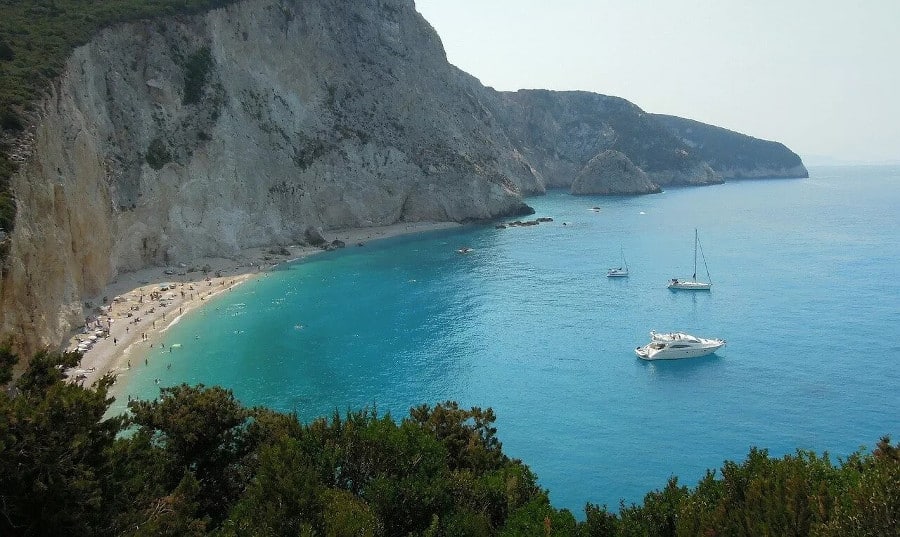Lefkada, the fourth largest of the Ionian Islands, stands out for its rich Venetian heritage and breathtaking natural beauty. Nestled off the western coast of Greece, this picturesque island, also known as Lefkas, is famous for its crystal-clear waters, dramatic cliffs, and lush greenery, making it a top destination for travellers seeking a blend of nature and authentic Greek culture.
One of Lefkada’s most distinctive features is its easy accessibility. Unlike other Greek islands requiring a ferry, Lefkada is connected to the mainland by a floating bridge, allowing visitors to reach it effortlessly by car while preserving its island charm.
Gastronomy: A Taste of Lefkada
Lefkada’s cuisine is a harmonious blend of traditional Greek flavours and local specialities, influenced by Venetian rule and mainland Greece. The island offers a variety of must-try dishes:
- Savoro: A traditional fish dish prepared with rosemary, garlic, and vinegar, showcasing Venetian influence.
- Eglouvis Lentils: A unique and flavorful local lentil variety cooked traditionally or served as a hearty salad with vegetables.
- Salami Aeros: This is a signature Lefkadian salami seasoned with garlic and whole peppercorns. Pork sausages quenched with red wine add depth to their flavour.
The island also boasts a variety of seafood, thanks to the traditional fishing techniques practised in the lagoons of the Amvrakikos Gulf. Highlights include:
- Salted Cod Bianco: Cod cooked with oil, lemon, garlic, and onion.
- Octopus in Wine: Slow-cooked octopus infused with wine and herbs.
- Lagoon Shrimp: Small, fried shrimp from Lefkada’s lagoons, renowned for their delicate flavour.
Additional seafood dishes include cuttlefish cooked in its ink, mussels steamed with herbs, maridopita (a pie made with small fish), and bonito or mackerel baked on tiles for a unique, earthy flavour.
Local Wines and Olive Oil
Lefkada produces exceptional wines, particularly from the Vertzami grape, known for its deep red colour, robust flavour, and white Vardea variety. Pairing these wines with the island’s high-quality olive oil elevates the dining experience, making vineyard and olive mill visits a must for food enthusiasts.
Traditional Dishes and Appetizers
- Riganada: A simple yet flavorful appetizer made with soaked dry bread, drizzled with olive oil and vinegar, sprinkled with oregano, and served with tomatoes and salted sardines.
- Rooster Pastitsada: This comforting dish features a rooster cooked in a rich red sauce and served with thick spaghetti. It is popular during family gatherings.
- Tiropita Kouloura: A traditional cheese pie rolled into a circular shape, often served as a snack or light meal.
- Fava Beans from Karya: Locally grown fava beans, cooked as a puree or in salads, offering a taste of Lefkada’s agricultural heritage.
During fasting, the locals turn to seafood-based dishes such as chavarosoupa (a mollusc soup) and mussel soup, maintaining a rich culinary tradition even during religious observance.
Sweets and Desserts
Lefkada’s desserts are equally tempting:
- Ladopita is a local halva-like dessert made with olive oil, flour, and sugar, baked to perfection.
- Pasteli: A sesame and honey bar, often enjoyed as a sweet snack.
- Mandolato and Mandoles: Traditional nougat and caramelized almonds commonly found in local markets.
- Sykomaida: A fig-based dessert made with grape must, offering a rich, fruity flavour.
In the villages, households often prepare and store petimezi (grape molasses), soutzouki (grape must roll), and sun-dried moustalevria (a grape-based pudding), preserving the island’s sweet traditions throughout the year.
Conclusion
Lefkada’s culinary landscape is as captivating as its natural beauty. With a cuisine deeply rooted in tradition and enriched by Venetian and mainland influences, the island offers a gastronomic journey that delights every palate. Whether savouring fresh seafood, tasting local wines or indulging in traditional sweets, visitors to Lefkada are sure to leave with a lasting impression of its rich flavours and warm hospitality.




